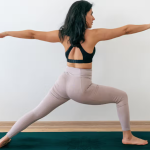Logic tells us that gluteus medius and minimus are to be found somewhere near their larger cousin, gluteus maximus. But how many of us yoga teachers really know where they really are and what they do? Let’s explore how you can target the gluteus medius and minimus in your practice and make the most of these muscles in your classes.
(If you missed our article about the gluteus maximus, it might be a good idea to start with that one!)
Location, Location, Location
Taking their origin from the iliac crest of the pelvis, just in front of gluteus maximus, gluteus medius and minimus make up the most lateral muscle bulk in the hip area. Medius is closest to the skin with minimus snuggled underneath, right next to the ilium. The fibres of both muscles pass down and attach on to the greater trochanter – that bony lump on the outer part of the upper femur. You can feel it as a bony knob at the widest part of your hips. In slim people with good muscle definition you can sometimes see a dimple in the muscles on the side of the hip that shows you where these glutes are.
Form and Function
Gluteus medius and minimus do a few things at the hip.
- Abducting the femur and hold the pelvis level when we stand on one leg. Every time you take one foot off the ground, these oft forgotten heroes of he weight bearing hip activate to keep us upright. If we relate that to asana, gluteus medius and minimus are working hard on the standing leg of single leg balances like Tree Pose, Dancer and Warrior 3.
- Internally rotating the hip. Or more accurately, counteracting other muscles to prevent the leg turning out when the hip is flexed. Specifically, it is the anterior fibres that work to neutralise the external rotating action of gluteus maximus.
- Externally rotating the hip. The posterior fibres of gluteus medius do this as well as abducting and extending the hip. This action is vital for putting the leg in a mechanically efficient position as it becomes the weight bearing limb with every step we take.
And, as always, muscles don’t work alone. Tensor fascia lata teams up with piriformis as synergists to medius and minimus at various times during hip movements, so there is a lot going on…
But what does this mean in the practice?
Glutes Medius on the Mat
As I have already mentioned, weakness of gluteus medius and minimus will limit a persons ability to perform single leg balances. You will immediately know that a student is weak here when you see the pelvis on the non-weightbearing side drop when they stand on the other leg. This is called a positive Trendelenburg’s sign and clearly tells you that strengthening work is needed!
Tightness of gluteus medius and minimus will limit any poses that involve external rotation of the hip. Particularly when the hip is flexed and needs to externally rotate e.g. pigeon front leg, ardha baddha padma pascimottanasana and Lotus variants. Take a look:
Excessive external rotation at the hips in some back bends may indicate that medius and minimus are not strong enough to counteract the action of gluteus maximus as it extends and externally rotates the hip. Look out for this in Wheel Pose in particular.
See Also: 4 Steps to Safer Back Bends
What Every Yoga Teacher Should Know
It is really common to find weakness and tightness in gluteus medius and minimus, so incorporating stretching and strengthening work into your classes will reap benefits for most students. But how can you get the best out of these muscles when you teach? And when is it safe to work into those coveted, advanced poses?
- Keep the pelvis level — If students drop the non-weight bearing side of their pelvis in single leg balances, encouraging them to lift that hip and shorten the trunk on the dropped side. To achieve this they will have to engage gluteus medius and minimus on the weight bearing leg.
- Stretching — Accessible versions of poses that require a lot of external rotation at the hip are suitable for beginners and can be sequenced early in more advanced classes as preparatory work. Poses like seated forward flexion with legs crossed, modified Fire Log and Sleeping Pigeon will be ideal for anyone who is not yet ready to attempt the more advanced versions. Ensure practice includes left over right and right over left leg positions to balance the stretch in both hips.
- Preparation and more preparation — Iconic poses like Lotus and ardha baddha padma pascimottanasana need lots of length in gluteus medius and minimus. More than many of us will ever have. Where these muscles are tight, the knees are forced to compensate causing pain and bringing a real risk of knee injury. Any discomfort in the knees in these poses is a warning sign that all is not well. Students should to be counselled to listen to their body and ease back to a more accessible version of the pose when any knee discomfort is felt.
See Also: 5 Poses to Healthy Happy Hips
And so to the Mat…
Where does this all leave us? For many it will take many months or years of patient work on these small but influential muscles before iconic asanas like Pigeon and Lotus can be achieved. Some of us will never get there. But wherever we are in our practice, working with our body and not forcing it before it is ready is what is needed.
Frequently forgotten these muscles may be — but inconsequential they are not! Steady stretching and strengthening is the way forwards — enjoy the journey and your hips will love you for it.













